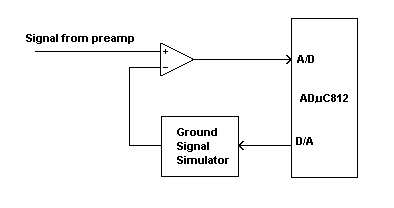
The ink was hardly dry on my last post saying that I would not be able to get any more signal out of the 10 bit A/D, when I figured out a possible way to get more signal for the All Metal mode. I was looking at the circuit and trying to figure out how I could balance out some of the ground signal without adding too much hardware. The conventional way to do it is to demodulate and ground balance in hardware to get an all metal signal that can be read with fewer A/D bits. For discrimination, at least some of the motion filtering is done in hardware. But I am stubbornly clinging to my notion of doing the demodulation in the processor.
The Analog Devices ADuC812 is an interesting chip because it has a 12 bit A/D and two 12 bit D/A's. That presents the possibility of using a design like the one above that would use a D/A to create a synthetic ground signal that could be subtracted from the actual ground signal. Then the A/D would only have to read the error between the simulated and the actual ground signals. This would allow more gain to be used. I was looking at this as a future project.
That's when it occurred to me that I can do a rough ground balance before the A/D without adding any hardware. It is not very practical to move the A/D sampling points relative to the timer interrupt, but I can move the coil drive signal. I decided to give up the variable width drive signal in favor of a variable phase drive signal. One cycle of the transmit signal is 152 usec. The timer clock has a resolution of 4 usec. So there are 38 possible angles at which I can position the drive signal relative to the A/D sample times. That lets me move the zero crossing of the ground signal to within about 4.5 degrees of one of the sample points. At that angle the signal is less than 10% of its peak value. So I could use 10 times as much gain in that channel without going out of the A/D range. I will have to do the remainder of the ground balancing in software.
This required changing to 4 interrupts per cycle instead of the two I have been using. But the one resource I still had a lot of was processor cycles. It seems worth it to give up some processor time to get more sensitivity. I have tested the variable phase drive and it seems to work ok. I will have to build some more gain into the preamp. And I will have to let the two channels scale themselves independently. Right now when the signal gets too large both channels automatically switch to low gain even if only one of them is close to overloading.
Unfortunately this will not help in target ID because it only gives more sensitivity in one channel.
Robert Hoolko
